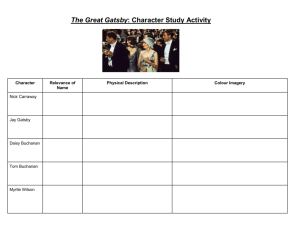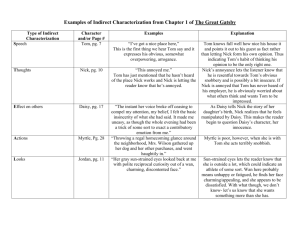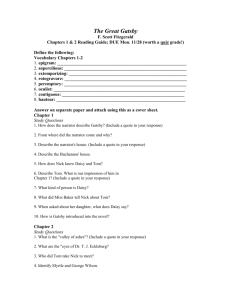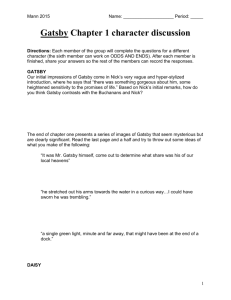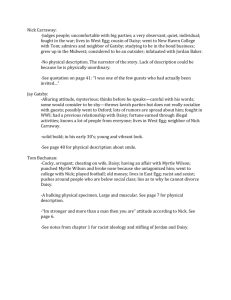Introduction to the Exposition and Characterization
advertisement
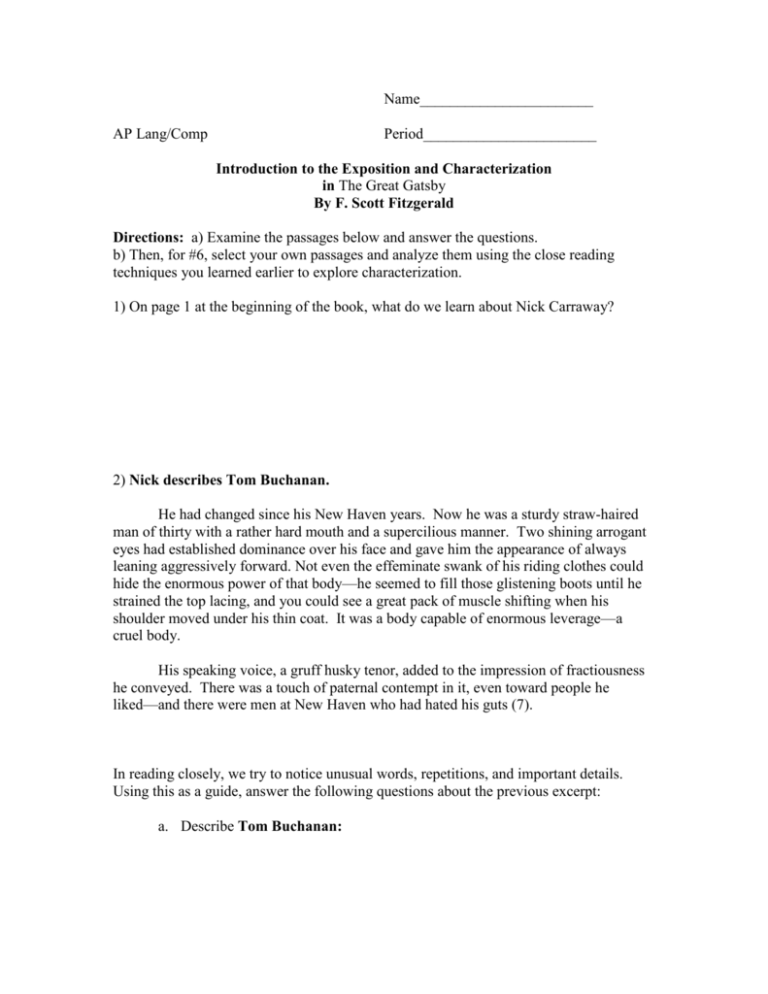
Name_______________________ AP Lang/Comp Period_______________________ Introduction to the Exposition and Characterization in The Great Gatsby By F. Scott Fitzgerald Directions: a) Examine the passages below and answer the questions. b) Then, for #6, select your own passages and analyze them using the close reading techniques you learned earlier to explore characterization. 1) On page 1 at the beginning of the book, what do we learn about Nick Carraway? 2) Nick describes Tom Buchanan. He had changed since his New Haven years. Now he was a sturdy straw-haired man of thirty with a rather hard mouth and a supercilious manner. Two shining arrogant eyes had established dominance over his face and gave him the appearance of always leaning aggressively forward. Not even the effeminate swank of his riding clothes could hide the enormous power of that body—he seemed to fill those glistening boots until he strained the top lacing, and you could see a great pack of muscle shifting when his shoulder moved under his thin coat. It was a body capable of enormous leverage—a cruel body. His speaking voice, a gruff husky tenor, added to the impression of fractiousness he conveyed. There was a touch of paternal contempt in it, even toward people he liked—and there were men at New Haven who had hated his guts (7). In reading closely, we try to notice unusual words, repetitions, and important details. Using this as a guide, answer the following questions about the previous excerpt: a. Describe Tom Buchanan: b. What important diction does Fitzgerald use to describe him? List at least five phrases below: c. What does this description tell you about Nick? Now examine this additional passage about Tom Buchanan, focusing on the same questions above: “Civilization’s going to pieces,” broke out Tom violently. “I’ve gotten to be a terrible pessimist about things. Have you read THE RISE OF THE COLORED EMPIRES by this man Goddard?” “Why, no,” I answered, rather surprised by his tone. “Well, it’s a fine book, and everybody ought to read it. The idea is if we don’t look out the white race will be—will be utterly submerged. It’s all scientific stuff; it’s been proved.” “Tom’s getting very profound,” said Daisy, with an expression of unthoughtful sadness. “He reads deep books with long words in them. What was the word we…” “Well, these books are all scientific,” insisted Tom, glancing at her impatiently. “This fellow has worked out the whole thing. It’s up to us, who are the dominant race, to watch out or these other races will have control of things.” “We’ve got to beat them down,” whispered Daisy, winking ferociously toward the fervent sun. “You ought to live in California…” began Miss Baker, but Tom interrupted her by shifting heavily in his chair. “The idea is that we’re Nordics. I am, and you are, and you are, and…” After an infinitesimal hesitation he included Daisy with a slight nod, and she winked at me again. “And we’ve produced all the things that go to make civilization—oh, science and art, and all that. Do you see?” There was something pathetic in his concentration, as if his complacency, more acute than of old, was not enough to him any more (13-14). 3. Nick describes Daisy and Jordan Baker. “The only completely stationary object in the room was an enormous couch on which two young women were buoyed up as though upon an anchored balloon. They were both in white, and their dresses were rippling and fluttering as if they had just been blown in after a short flight around the house. I must have stood for a few moments listening to the whip and snap of the curtains and the groan of a picture on the wall. Then there was a boom as Tom Buchanan shut the windows and the caught wind died out about the room, and the curtains and the rugs and the two young women ballooned slowly to the floor (page 8).” a. Describe your initial impression of the two women on the couch. b. What important diction does Fitzgerald use to describe him? List at least five phrases below: c. What does this description tell you about Nick? 4. Nick describes Jordan Baker. “The younger of the two was a stranger to me. She extended full length at her end of the divan, completely motionless, and with her chin raised a little, as if she were balancing something on it which was quite likely to fall. If she saw me out of the corner of her eyes, she gave no hint of it—indeed, I was almost surprised into murmuring an apology for having disturbed her by coming in (pages 8-9). a. Describe Jordan Baker b. What important diction does Fitzgerald use to describe her? List at least five phrases below: c. What does this description tell you about Nick? “…I enjoyed looking at her. She was a slender, small-breasted girl, with an erect carriage, which she accentuated by throwing her body backward at the shoulders like a young cadet. Her gray sun-strained eyes looked back at me with polite reciprocal curiosity out of a wan, charming, discontented face.” a. Describe Jordan Baker further. b. What important diction does Fitzgerald use to describe her here? List at least five phrases below: c. What does this description tell you about Nick? 5. Nick describes Daisy. The other girl, Daisy, made an attempt to rise—she leaned slightly forward with a conscientious expression—then she laughed, an absurd, charming little laugh, and I laughed too and came forward into the room. “I’m p-paralyzed with happiness.” She laughed again, as if she said something very witty, and held my hand for a moment, looking up into my face, promising that there was no one in the world she so much wanted to see. I looked back at my cousin, who began to ask me questions in her low, thrilling voice. It was the kind of voice that the ear follows up and down, as if each speech is an arrangement of notes that will never be played again. Her face was sad and lovely with bright things in it, bright eyes and a bright passionate mouth, but there was an excitement in her voice that men who cared for her found difficult to forget: a singing compulsion, a whispered “Listen,” a promise that she had done gay, exciting things just a while since and that there were gay, exciting things hovering in the next hour (9). a. Describe Daisy. b. What words does Fitzgerald use to reveal Daisy’s character? c. What do we learn about Nick from his description? 6) Using this process of analysis, read chapters 2 and 3, singling out important passages that use detail to reveal characters. Bring in a clean copy of a passage you choose from the chapter you were assigned in class.


